Abstract
Secondary mitotic human skin fibroblast populations in vitro underwent 53 +/- 6 cumulative population doublings (CPD) in 302 +/- 27 days. When the growth capacity of the mitotic fibroblasts is exhausted, and if appropriate methods are applied, the fibroblasts differentiate spontaneously into postmitotic fibroblast populations, which were kept in stationary culture for up to 305 +/- 41 additional days. Mitotic and postmitotic fibroblast populations are heterogeneous populations with reproducible changes in the proportions of mitotic fibroblasts F I, F II, and F III, and postmitotic fibroblasts F IV, F V, F VI, and F VII. This process makes it evident that the fibroblasts differentiate spontaneously along a seven-stage terminal cell lineage F I-F II-F III-F IV-F V-F VI-F VII. Shifts in the frequencies of the mitotic and postmitotic fibroblasts in mass populations are accompanied by alterations in the [35S]methionine polypeptide pattern of the developing mass populations. The [35S]methionine polypeptide patterns of homogeneous subpopulations of F I, F II, F III, F IV, F V, and F VI isolated from heterogeneous mass populations reveal that the six fibroblast morphotypes studied express their cell-type-specific [35S]methionine polypeptide pattern in the heterogeneous mass populations.
Full text
PDF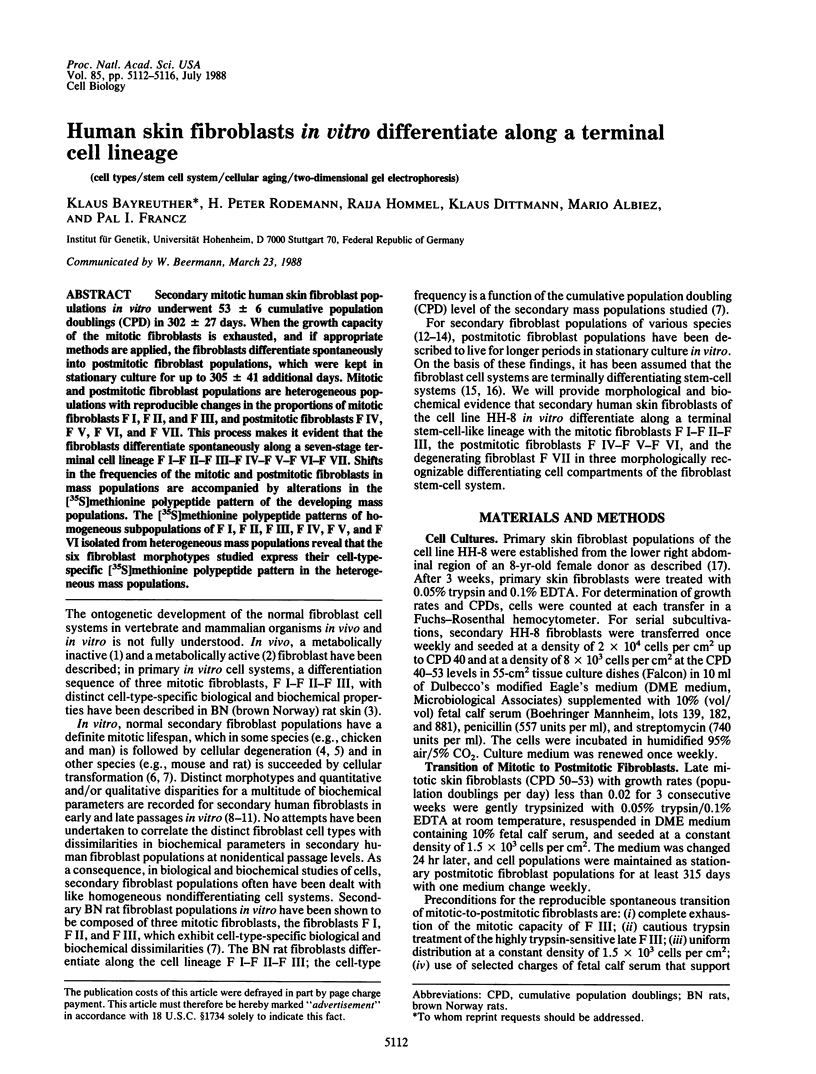
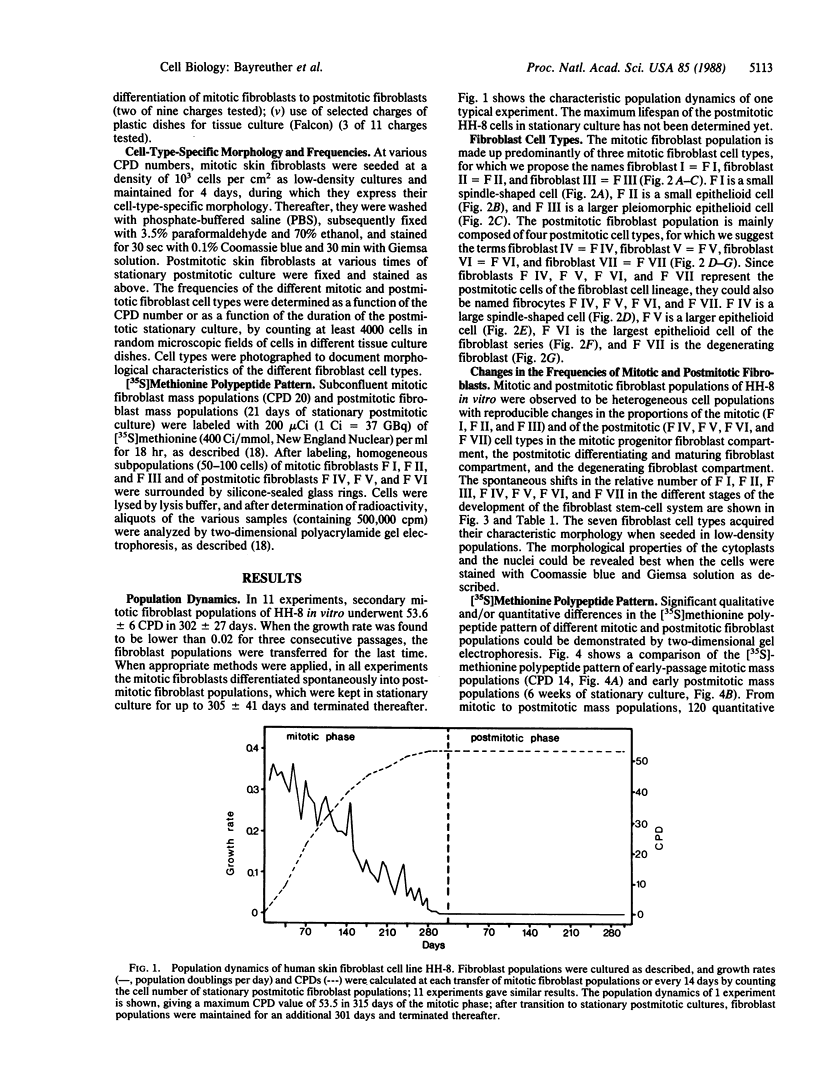
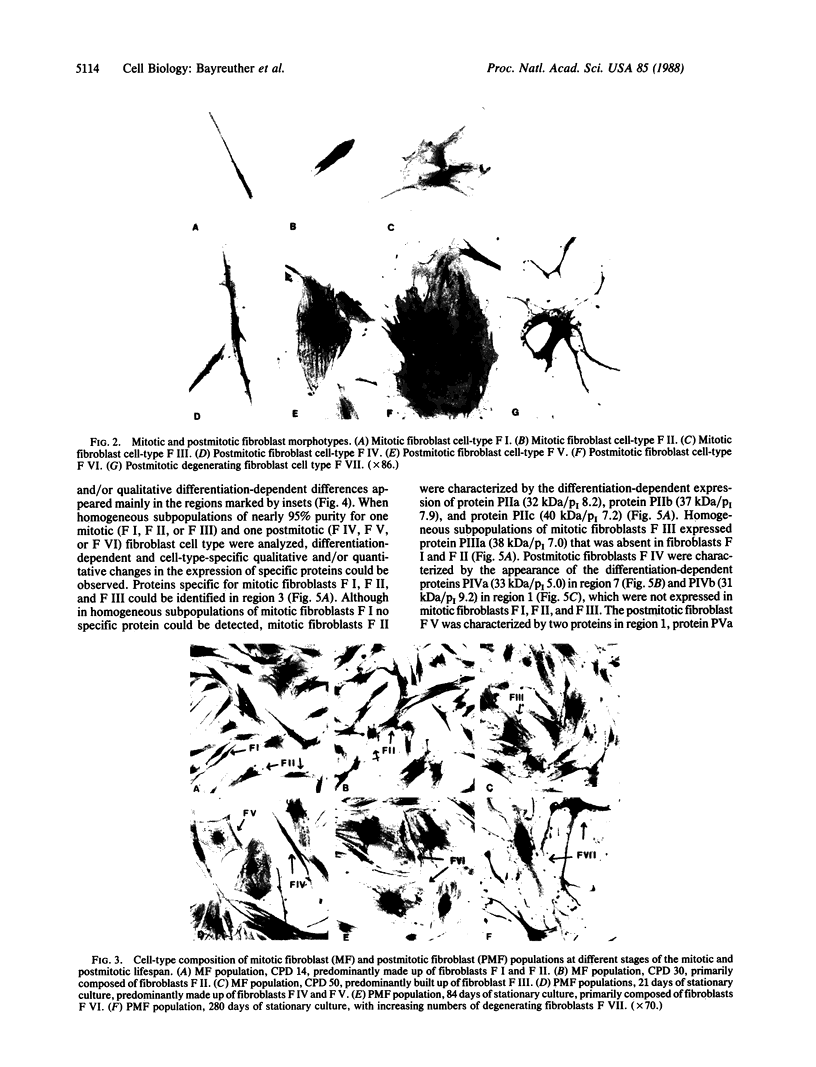
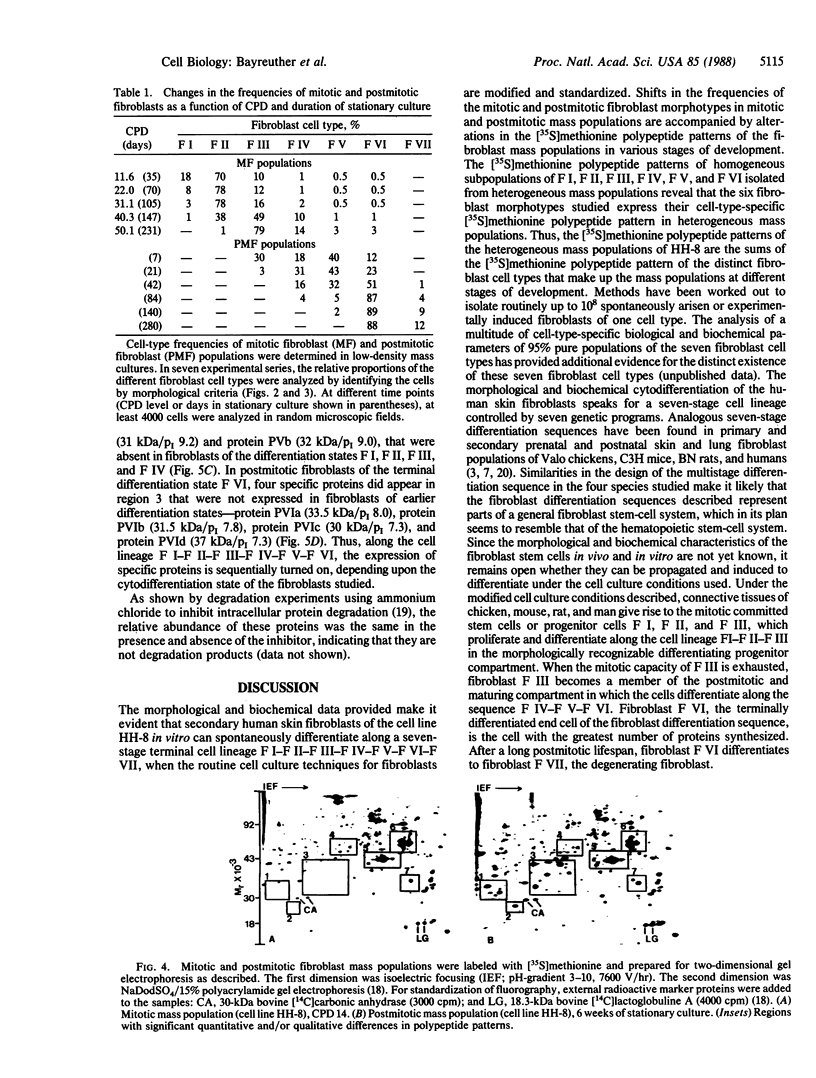
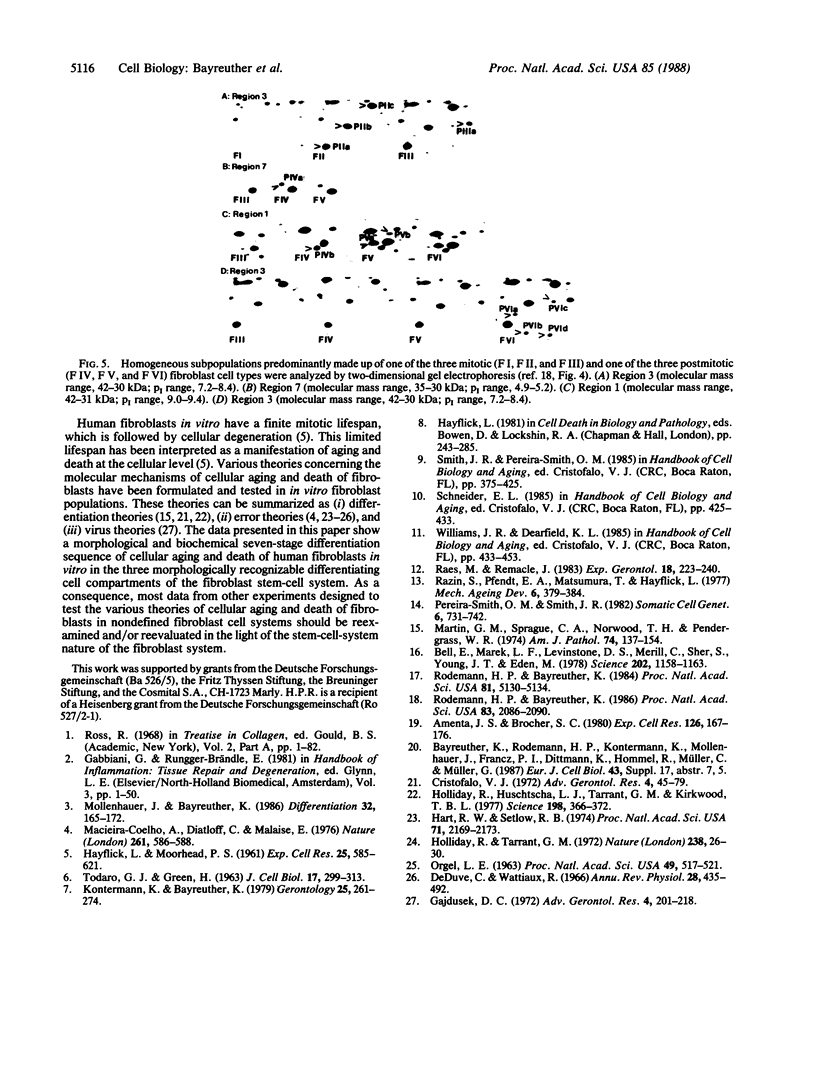
Images in this article
Selected References
These references are in PubMed. This may not be the complete list of references from this article.
- Amenta J. S., Brocher S. C. Mechanisms of protein turnover in cultured fibroblasts. Differential inhibition of two lysosomal mechanisms with insulin and NH4Cl. Exp Cell Res. 1980 Mar;126(1):167–174. doi: 10.1016/0014-4827(80)90482-6. [DOI] [PubMed] [Google Scholar]
- Bell E., Marek L. F., Levinstone D. S., Merrill C., Sher S., Young I. T., Eden M. Loss of division potential in vitro: aging or differentiation? Science. 1978 Dec 15;202(4373):1158–1163. doi: 10.1126/science.725592. [DOI] [PubMed] [Google Scholar]
- De Duve C., Wattiaux R. Functions of lysosomes. Annu Rev Physiol. 1966;28:435–492. doi: 10.1146/annurev.ph.28.030166.002251. [DOI] [PubMed] [Google Scholar]
- HAYFLICK L., MOORHEAD P. S. The serial cultivation of human diploid cell strains. Exp Cell Res. 1961 Dec;25:585–621. doi: 10.1016/0014-4827(61)90192-6. [DOI] [PubMed] [Google Scholar]
- Hart R. W., Setlow R. B. Correlation between deoxyribonucleic acid excision-repair and life-span in a number of mammalian species. Proc Natl Acad Sci U S A. 1974 Jun;71(6):2169–2173. doi: 10.1073/pnas.71.6.2169. [DOI] [PMC free article] [PubMed] [Google Scholar]
- Holliday R., Huschtscha L. I., Tarrant G. M., Kirkwood T. B. Testing the commitment theory of cellular aging. Science. 1977 Oct 28;198(4315):366–372. doi: 10.1126/science.910134. [DOI] [PubMed] [Google Scholar]
- Holliday R., Tarrant G. M. Altered enzymes in ageing human fibroblasts. Nature. 1972 Jul 7;238(5358):26–30. doi: 10.1038/238026a0. [DOI] [PubMed] [Google Scholar]
- Kontermann K., Bayreuther K. The cellular aging of rat fibroblasts in vitro is a differentiation process. Gerontology. 1979;25(5):261–274. doi: 10.1159/000212351. [DOI] [PubMed] [Google Scholar]
- Macieira-Coelho A., Diatloff C., Malaise E. Doubling potential of fibroblasts from different species after ionising radiation. Nature. 1976 Jun 17;261(5561):586–588. doi: 10.1038/261586a0. [DOI] [PubMed] [Google Scholar]
- Martin G. M., Sprague C. A., Norwood T. H., Pendergrass W. R. Clonal selection, attenuation and differentiation in an in vitro model of hyperplasia. Am J Pathol. 1974 Jan;74(1):137–154. [PMC free article] [PubMed] [Google Scholar]
- Mollenhauer J., Bayreuther K. Donor-age-related changes in the morphology, growth potential, and collagen biosynthesis in rat fibroblast subpopulations in vitro. Differentiation. 1986;32(2):165–172. doi: 10.1111/j.1432-0436.1986.tb00569.x. [DOI] [PubMed] [Google Scholar]
- ORGEL L. E. The maintenance of the accuracy of protein synthesis and its relevance to ageing. Proc Natl Acad Sci U S A. 1963 Apr;49:517–521. doi: 10.1073/pnas.49.4.517. [DOI] [PMC free article] [PubMed] [Google Scholar]
- Pereira-Smith O. M., Smith J. R. Phenotype of low proliferative potential is dominant in hybrids of normal human fibroblasts. Somatic Cell Genet. 1982 Nov;8(6):731–742. doi: 10.1007/BF01543015. [DOI] [PubMed] [Google Scholar]
- Raes M., Remacle J. Ageing of hamster embryo fibroblasts as the result of both differentiation and stochastic mechanisms. Exp Gerontol. 1983;18(3):223–240. doi: 10.1016/0531-5565(83)90034-7. [DOI] [PubMed] [Google Scholar]
- Razin S., Pfendt E. A., Matsumura T., Hayflick L. Comparison by autoradiography of macromolecular biosynthesis in "young" and "old" human diploid fibroblast cultures. A brief note. Mech Ageing Dev. 1977 Sep-Oct;6(5):379–384. doi: 10.1016/0047-6374(77)90039-2. [DOI] [PubMed] [Google Scholar]
- Rodemann H. P., Bayreuther K. Abnormal collagen metabolism in cultured skin fibroblasts from patients with Duchenne muscular dystrophy. Proc Natl Acad Sci U S A. 1984 Aug;81(16):5130–5134. doi: 10.1073/pnas.81.16.5130. [DOI] [PMC free article] [PubMed] [Google Scholar]
- Rodemann H. P., Bayreuther K. Differential degradation of [35S]methionine polypeptides in Duchenne muscular dystrophy skin fibroblasts in vitro. Proc Natl Acad Sci U S A. 1986 Apr;83(7):2086–2090. doi: 10.1073/pnas.83.7.2086. [DOI] [PMC free article] [PubMed] [Google Scholar]
- TODARO G. J., GREEN H. Quantitative studies of the growth of mouse embryo cells in culture and their development into established lines. J Cell Biol. 1963 May;17:299–313. doi: 10.1083/jcb.17.2.299. [DOI] [PMC free article] [PubMed] [Google Scholar]






